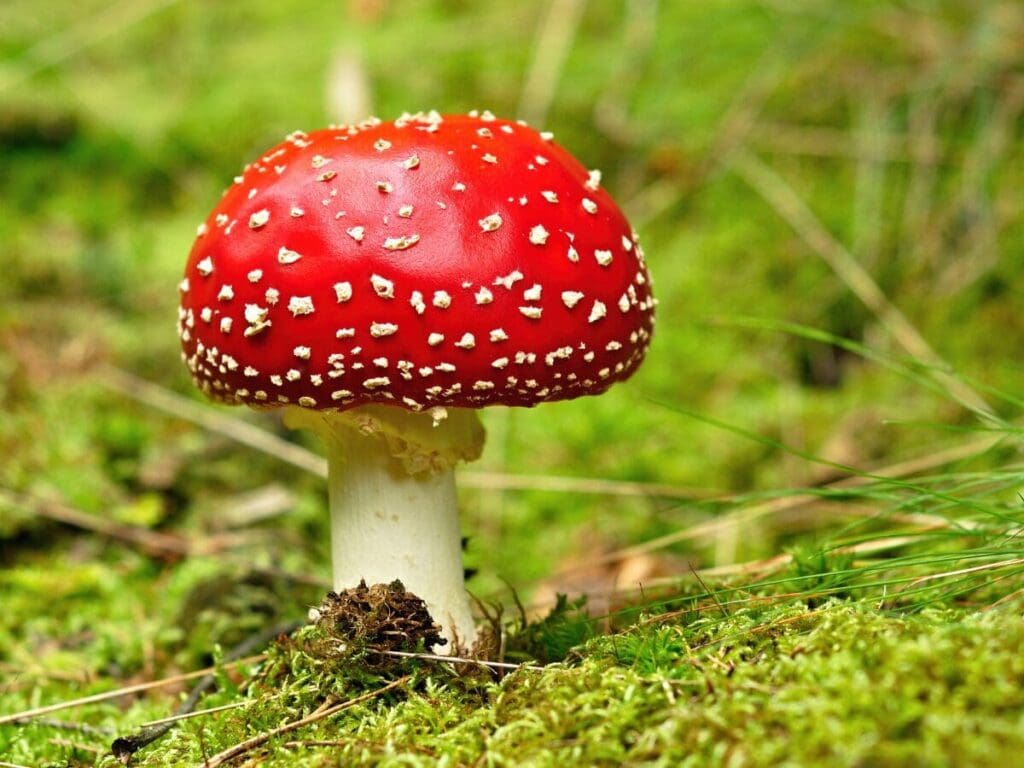Key Takeaways:
- Unpredictable Energy Effects: Amanita muscaria may not reliably boost energy and can even cause sedation.
- Comparison to Stimulants: Unlike caffeine, it affects mental clarity and physical stamina unpredictably.
- Potential Risks: The mushroom’s psychoactive properties and possible toxicity present significant health concerns.
Looking for a way to boost your energy naturally? While most people turn to coffee or sugary energy drinks for a quick pick-me-up, there’s growing curiosity around Amanita muscaria—a mushroom steeped in folklore and known for its striking red-and-white appearance. But can this mysterious mushroom actually enhance your energy levels?
At Happy Hemp, we pride ourselves on offering innovative, natural health products that deliver real results. Our Amanita Muscaria gummies blend tradition and science, offering a unique way to experience this fascinating mushroom.
In this article, we’ll uncover the truth behind Amanita muscaria’s effects and whether it can truly boost your energy.
Traditional Uses Of Amanita Muscaria
Amanita muscaria, commonly known as the fly agaric, has a long history of use across various cultures, particularly among indigenous groups in Siberia. While much of its modern notoriety comes from its psychoactive properties, the mushroom played significant roles in spiritual and medicinal practices. Below, we explore the traditional uses of Amanita muscaria, focusing on its spiritual, ritualistic, and medicinal applications.
Spiritual Use In Rituals
In Siberian shamanic traditions, Amanita muscaria was consumed to induce altered states of consciousness. Shamans believed these states allowed them to communicate with spirits and gain access to divine knowledge. The mushroom’s psychoactive effects were integral to these spiritual journeys, acting as a conduit between the physical and spiritual worlds.
Medicinal Use For Pain And Anxiety
Beyond its spiritual significance, Amanita muscaria was also employed for medicinal purposes. Healers sometimes administered the mushroom to alleviate pain and anxiety. While these treatments were not scientifically studied, anecdotal reports suggest that the mushroom had sedative properties, helping people manage stress or discomfort.
Use For Fatigue And Endurance
In some traditions, Amanita muscaria was believed to provide bursts of energy or endurance during lengthy rituals or ceremonies. Although it was not used as a conventional stimulant, some practitioners noted a temporary increase in physical stamina. However, this effect was secondary to its primary role in spiritual practices, rather than being its main purpose.
Complex Role In Traditional Contexts
Rather than being viewed as a simple energy enhancer, Amanita muscaria was valued for its multifaceted role in spiritual and medicinal contexts. Its effects were seen as holistic, blending mental, spiritual, and physical experiences. The mushroom’s use was deeply intertwined with the cultural and religious beliefs of the people who used it, adding layers of meaning beyond its physiological effects.
Experience the unique benefits of Amanita Muscaria with Happy Hemp’s premium gummies. Whether you’re curious about natural wellness or seeking an alternative way to enhance your energy and relaxation, our carefully crafted Amanita Muscaria gummies offer a safe and easy way to explore this iconic mushroom. Visit our website to discover more and elevate your wellness journey with Happy Hemp today!
The Active Compounds In Amanita Muscaria
Amanita muscaria, a mushroom known for its distinctive appearance, owes much of its psychoactive effects to two primary compounds: muscimol and ibotenic acid. These substances interact with the body in complex ways, influencing perception and mental states. Below is a breakdown of how these active compounds work and their effects on the body.
Muscimol: A Potent Psychoactive Agent
Muscimol is the most prominent compound in Amanita muscaria responsible for its psychoactive properties. It binds to GABA receptors in the brain, which typically result in relaxation and sedation. While it can induce euphoria and altered perception, muscimol also causes drowsiness and detachment, making its overall effects variable based on dosage and individual sensitivity.
Ibotenic Acid: Toxic But Transformative
Ibotenic acid is a neurotoxin present in the raw form of the mushroom. When ingested, it can cause nausea, dizziness, and hallucinations, but when the mushroom is dried or processed, this compound converts into muscimol. The transformation of ibotenic acid into muscimol reduces its toxicity, but it still retains potent psychoactive effects, which can be unpredictable in nature.
Indirect Impact On Energy Levels
Although muscimol and ibotenic acid influence consciousness and perception, they do not have direct energy-boosting properties. In fact, due to their sedative qualities, these compounds are more likely to induce relaxation and calmness rather than enhance energy. This paradoxical relationship highlights the complex interaction between Amanita muscaria’s compounds and the brain, resulting in varied effects depending on preparation and consumption.
How Amanita Muscaria Affects The Body And Mind
Amanita muscaria is known for its unique and varied effects on both the body and mind. Depending on factors such as dosage, method of preparation, and individual sensitivity, the experience can range from mild relaxation to intense dissociation. The following sections explore the physical and mental effects of consuming this mushroom in more detail.
- Sedation and Relaxation: Muscimol, the key psychoactive compound in Amanita muscaria, binds to GABA receptors in the brain, resulting in a sedative effect. This leads to deep relaxation, often progressing to drowsiness or even sleep. Rather than providing a sense of heightened energy, the mushroom is more commonly associated with feelings of tranquility and reduced physical activity.
- Muscle Relaxation and Heaviness: Users frequently report sensations of heaviness in the limbs and general muscle relaxation. This effect is linked to the mushroom’s influence on the central nervous system, further reinforcing its reputation as a substance that diminishes energy and encourages physical stillness rather than enhancing stamina or strength.
- Altered Perception and Disorientation: In higher doses, Amanita muscaria can cause significant changes in perception. Users may experience visual distortions, a sense of floating, or detachment from their body. These sensations can be disorienting and make it difficult to engage in tasks requiring focus or coordination, adding to the mushroom’s sedative profile.
- Temporary Euphoria: Amanita muscaria is sometimes associated with feelings of euphoria, which can briefly mimic an increase in energy. However, this sensation is more of an emotional uplift rather than a true enhancement of physical or mental vitality. The euphoria is typically short-lived, often giving way to relaxation or sedation.
- Cognitive Impairment and Confusion: Another common mental effect of Amanita muscaria is cognitive impairment. Users often experience confusion, difficulty in decision-making, and a general fogginess in thought processes. This mental state can make it challenging to perform even simple tasks, further counteracting any notion of increased energy or mental clarity.
- Dream-like States and Hallucinations: At higher doses, muscimol can induce dream-like states, often accompanied by hallucinations. While these experiences can be profound or stimulating on a psychological level, they are not conducive to tasks requiring focus, concentration, or physical effort. Instead, they contribute to a deeper sense of mental and physical detachment.
Amanita muscaria’s effects are multifaceted but predominantly characterized by sedation, muscle relaxation, and altered perception. Any fleeting sense of increased energy is usually overshadowed by its more calming and disorienting effects.
How To Safely Consume Amanita Muscaria For Potential Benefits
Amanita muscaria has a long history of traditional use, but its consumption must be approached with caution due to the potential risks associated with its active compounds. Careful preparation is essential to reduce toxicity and unlock the mushroom’s potential benefits. Below, we explore the key steps to safely consume Amanita muscaria, with a focus on preparation, dosage, and expert guidance.
Drying The Mushroom To Reduce Toxicity
One of the most important steps in preparing Amanita muscaria for consumption is drying the mushroom. This process helps convert the toxic ibotenic acid into muscimol, the psychoactive compound responsible for its effects. Drying the mushroom properly can significantly reduce the risk of toxicity, making it safer for consumption. However, it is crucial to follow the correct drying methods to ensure this conversion takes place effectively.
Boiling And Parboiling For Safety
In addition to drying, boiling or parboiling Amanita muscaria is another traditional method used to reduce its toxicity. By boiling the mushroom in water, some of the harmful compounds are leached out, further decreasing the risk of adverse effects. This step is often recommended for those who are new to consuming the mushroom, as it adds an extra layer of safety when preparing it for ingestion.
Start With A Low Dose To Gauge Sensitivity
Given the variability in individual reactions to Amanita muscaria, it is critical to start with a very low dose. Each person’s sensitivity to muscimol can differ, and starting with a small amount allows users to assess how their body responds before increasing the dose. Taking a cautious approach minimizes the risk of overwhelming or unwanted effects, which can be intense even in small quantities.
Consult An Expert Or Herbalist Before Use
Because of the potential dangers associated with improper preparation or dosing, consulting with an expert or experienced herbalist is highly recommended before consuming Amanita muscaria. These professionals can provide guidance on safe practices, proper preparation techniques, and appropriate dosage, reducing the likelihood of negative experiences. Seeking expert advice ensures that any potential benefits are maximized while minimizing risks.
What To Expect When Trying Amanita Muscaria For The First Time
For those new to Amanita muscaria, understanding the potential effects is essential to ensure a safe and comfortable experience. Unlike conventional energy supplements, Amanita muscaria has a wide range of effects that can vary from person to person, often leaning more towards relaxation than stimulation. Below, we discuss what to expect when trying this mushroom for the first time and how to approach it with caution.
Mild Relaxation And Sedation
One of the most common effects of Amanita muscaria is a feeling of deep relaxation or mild sedation. This is due to the compound muscimol, which interacts with GABA receptors in the brain, promoting calmness and reducing nervous system activity. First-time users often report a sense of tranquility or drowsiness, making it more suitable for winding down rather than boosting energy levels.
Altered Perception And Sensory Changes
Amanita muscaria may also produce changes in perception, especially at higher doses. Users might experience visual distortions, a sense of detachment from their body, or an altered awareness of their surroundings. While these effects are not as intense as those from more well-known psychedelics, they can still be disorienting, especially for beginners. It’s important to remain in a calm, familiar environment when experimenting with the mushroom for the first time.
Possible Euphoria But No Energy Boost
Although some users experience a temporary feeling of euphoria, this should not be mistaken for increased energy. The euphoria is more emotional than physical and often fades into feelings of drowsiness or mental fog. Unlike energy-boosting supplements that enhance alertness, Amanita muscaria typically leads to a more subdued and reflective state, making it unsuitable for tasks requiring focus or physical stamina.
Drowsiness And Physical Heaviness
A frequent effect of Amanita muscaria is a sensation of heaviness in the limbs and an overwhelming desire to rest. This physical sluggishness is common and may persist for several hours, reinforcing the mushroom’s reputation as more of a sedative than a stimulant. For first-time users, it’s wise to plan a calm, restful environment where relaxation can be fully embraced.
Final Thoughts
Amanita muscaria has a rich history in cultural and spiritual traditions, but it is far from reliable when it comes to energy enhancement. The active compounds, muscimol and ibotenic acid, are more likely to cause sedation, altered perception, and psychoactive effects rather than the sustained physical energy or mental focus that most people seek. For this reason, those looking to boost energy levels may find Amanita muscaria unsuitable, as its effects are unpredictable and often counterproductive for such purposes.
Traditional energy-boosting supplements like caffeine, ginseng, or adaptogens offer more consistent and safer results without the risk of toxicity or unpleasant side effects like nausea and fatigue. While Amanita muscaria may offer unique experiences, it is not recommended as an effective or practical way to increase energy. Anyone considering its use should be aware of the potential risks and approach it with caution.
Read also:
- Bong vs Pipe: Choosing the Right Smoking Device
- Bubbler vs Bong: Which Is Better for You?
- Cool Bongs: Unique Designs for Every Smoking Enthusiast
Frequently Asked Questions About Amanita Muscaria
Can Amanita Muscaria provide a natural energy boost?
Amanita muscaria may cause short bursts of perceived energy due to its psychoactive effects, but it is more likely to result in sedation and relaxation rather than sustained energy.
Is it safe to use Amanita Muscaria as an energy supplement?
Using Amanita muscaria for energy is not recommended due to its unpredictable psychoactive effects and potential risks, including nausea, confusion, and fatigue.
How does Amanita Muscaria compare to caffeine for energy?
Unlike caffeine, which is a reliable stimulant, Amanita muscaria does not provide consistent energy. It can cause altered states of consciousness rather than clear physical or mental stimulation.
Does Amanita Muscaria affect physical stamina?
While some users report temporary surges in energy, Amanita muscaria’s overall sedative effects often diminish physical stamina, leading to feelings of heaviness and drowsiness.
Can Amanita Muscaria help with mental focus and clarity?
No, Amanita muscaria typically impairs mental clarity and can cause confusion or cognitive disorientation, making it unsuitable for tasks requiring focus.
How long do the effects of Amanita Muscaria last?
The effects can last anywhere from several hours to a full day, depending on dosage and individual sensitivity. Most users experience a wave of sedation after an initial period of altered perception.
Are there any health benefits to using Amanita Muscaria?
Though used in traditional medicine for various ailments, Amanita muscaria is not widely recognized for health benefits today due to its psychoactive properties and potential risks.
Is Amanita Muscaria legal to use as a supplement?
The legality of Amanita muscaria varies by region. In some places, its use is regulated due to its psychoactive effects, so it’s important to check local laws before use.
Can Amanita Muscaria be used with other supplements?
Mixing Amanita muscaria with other supplements, especially stimulants, could be dangerous due to the mushroom’s unpredictable effects. It’s best to avoid combining it with other substances without consulting a healthcare provider.
What is the proper way to consume Amanita Muscaria?
Amanita muscaria should be properly dried or processed to reduce toxicity, but even then, its effects remain unpredictable. It’s essential to consult with an expert before considering consumption.
Sources:
- He, M.-Q., Wang, M.-Q., Chen, Z.-H., Deng, W.-Q., Li, T.-H., Vizzini, A., Jeewon, R., Hyde, K. D., & Zhao, R.-L. (2022). Potential benefits and harms: a review of poisonous mushrooms in the world. Fungal Biology Reviews, 42, 56–68. https://doi.org/10.1016/j.fbr.2022.06.002
- Cheung, P. C. K. (2010). The nutritional and health benefits of mushrooms. Nutrition Bulletin, 35(4), 292–299. https://doi.org/10.1111/j.1467-3010.2010.01859.x
- Barroetaveña, C., & Toledo, C. V. (2016). The Nutritional Benefits of Mushrooms. 65–81. https://doi.org/10.1002/9781118944653.ch3









